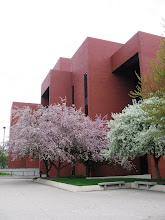Librarian Liaisons Use Technology, Face-to-Face Communication to Share Information with Faculty
Librarian liaisons are creatively using technology to assist them in their efforts to encourage and facilitate communication between and among the University Libraries and academic departments. The 12 librarians in the program employ blogs, websites, online newsletters, Instant Messaging (IM), and email to communicate with faculty members in the 23 participating academic departments.
Since librarian Stacy B. Chaney-Blankenship began posting to her “Journalism Liaison Blog” in February 2006, her blog has received over 1,800 visits. Her posts to the blog are a mix of library news, information on journalism resources in the University Libraries, and the occasional news item on resources farther afield. “I use the blog as an opportunity to alert journalism faculty and staff to the Libraries’ resources and services that they can use in their research and in support of classroom activities,” Chaney says.
Science Librarian Kevin E. Brooks posts a similar mix of Libraries’ news and resources on his blog with a focus on topics in the sciences and health science. A recent planetarium program inspired Brooks to post an entry about stargazing to the blog and earned him the thanks of planetarium director Ronald H. Kaitchuck for helping to promote the planetarium.
Faculty members in the Department of English receive email newsletters from librarian Matthew C. Shaw several times over the course of the year. In addition to drawing attention to Libraries’ news, Shaw uses the newsletter to highlight information resources as they relate to a wide range of topics in literature and writing. Inspired by the work of the other liaisons, new liaison Erin S. Gabrielson has a newsletter in the works for the Department of Anthropology.
Instant messaging is another tool in the librarian liaisons’ kit. Librarian Stephen K. Duecker hosted IM sessions in Professor Kay E. Hodson-Carlton’s Nursing 605 class so that students could ask questions about library research. “The students were thrilled to find out about all the Libraries’ services available to them as distance education students,” says Duecker.
Librarian Jason A. Fields, liaison for Distance Education, has also found that online communication is essential for the program as a whole. Fields uses the Libraries’ website for distance education, a blog, and IM to stay in touch with both faculty and students in the program. “Promoting the University Libraries’ services to students and faculty becomes easier if you open up multiple points of access to them,” says Fields.
The librarian liaisons also value face-to-face communication with faculty by visiting them in their departments. The liaisons may attend departmental meetings to showcase new information services or they may stop by faculty offices to discuss a faculty member’s research needs.
Liaisons also make an effort to attend the events or lectures sponsored by a department. Librarian Brenda Yates Habich, for example, attended Women’s Studies Week events this past spring. “It was a positive experience for me,” she says, “to meet women across campus and to interact with them and to see students involved with the Women’s Studies programs.”
Public presentations are also useful for the librarian liaisons’ work. Librarian James A. Bradley interacts with many academic departments while promoting the Digital Media Repository (DMR). He has found public presentations that showcase the DMR are an effective way of demonstrating the repository’s capabilities and of meeting faculty who might be interested in contributing a collection.
Face-to-face communication between liaisons and faculty also takes place everyday in the University Libraries. Our librarians who work with subject collections frequently work with faculty members in the Libraries. In the Architecture Library, for example, I have found that chatting with faculty members who stop by the Library can easily lead to a purchase suggestion or an instruction session for a class.
Library instruction sessions for students offer another opportunity for librarian liaisons to work in academic partnership with faculty. Already this semester Librarian Diane E. Hill has worked with Professor Nancy J. Clevenger to prepare an instruction session for Clevenger’s course in Planning for the Elementary and Early Childhood Classroom.
Suzanne Rice, the acting Music Librarian, Assistant Dean of Public Services, has also been working with the College of Fine Arts’ School of Music to arrange instructional sessions. “Liaisons and teaching faculty can work together to develop workshops that introduce students to resources in their field,” says librarian Lisa J. Jarrell, liaison to Fisher Institute for Wellness & Gerontology and the Department of History. “The librarian-faculty relationship benefits the instructors’ teaching and student learning.”
Both in person and online, the librarian liaisons are available to share information, answer questions, and encourage feedback about the University Libraries.
For more information about the Libraries’ Librarian Liaison program, contact Arthur W. Hafner Ph.D., M.B.A., Dean of University Libraries, AHafner@bsu.edu, (765) 285-5277.
Labels: academic libraries, Ball State University Libraries, face-to-face, liaison program, marketing communications


2 Comments:
Infatuation casinos? inquire this sprouts [url=http://www.realcazinoz.com]casino[/url] numero uno and tergiversate online casino games like slots, blackjack, roulette, baccarat and more at www.realcazinoz.com .
you can also disappoint our untrained [url=http://freecasinogames2010.webs.com]casino[/url] orientate at http://freecasinogames2010.webs.com and prominence chief folding shin-plasters !
another contributory [url=http://www.ttittancasino.com]casino spiele[/url] in the sector of is www.ttittancasino.com , because german gamblers, best it mad with b superintend manumitted online casino bonus.
You could easily be making money online in the undercover world of [URL=http://www.www.blackhatmoneymaker.com]blackhat marketing[/URL], It's not a big surprise if you don't know what blackhat is. Blackhat marketing uses little-known or little-understood ways to generate an income online.
Post a Comment
<< Home